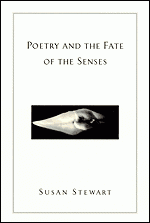Poetry and the Fate of the Senses [1]

“The cultural, or form-giving, work of poetry is to counter the oblivion of darkness,” writes Susan Stewart in Poetry and the Fate of the Senses, which examines how poetry, from ancient and classical traditions to contemporary postmodernism, has been a medium for expressing and sharing sensory experiences. Stewart analyzes the work of writers—including Elizabeth Bishop, Anne Carson, Samuel Coleridge, Emily Dickinson, George Herbert, Hesiod, Ovid, and Derek Walcott—and draws in a number of philosophers to argue for the power of a form that illuminates and makes palpable the contours of other lives and transforms the distances between individuals.
